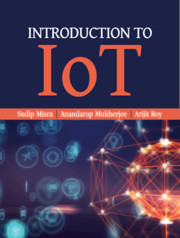12 - Agricultural IoT
Published online by Cambridge University Press: 09 January 2021
Summary
Learning Outcomes
After reading this chapter, the reader will be able to:
Relate to the applicability of IoT in real scenarios
List the salient features of agricultural IoT
Understand the requirements, challenges, and advantages in implementing IoT in agriculture
Relate to the appropriate use of various IoT technologies through real-life use cases on IoT-based leaf area index assessment and an IoT-based irrigation system
Introduction
Currently, IoT-enabled technologies are widely used for increasing crop productivity, generating significant revenue, and efficient farming. The development of the IoT paradigm helps in precision farming. Agricultural loT systems perform crop health monitoring, water management, crop security, farming vehicle tracking, automatic seeding, and automatic pesticide spraying over the agricultural fields. In an IoTbased agricultural system, different sensors necessarily have to be deployed over agricultural fields, and the sensed data from these sensors need to be transmitted to a centralized entity such as a server, cloud, or fog devices. Further, these data have to be processed and analyzed to provide various agricultural services. Finally, a user should be able to access these services from handheld devices or computers. Figure 12.1 depicts a basic architecture of an agricultural IoT.
Components of an agricultural IoT
The development of an agricultural IoT has helped farmers enhance crop productivity and reduce the overhead of manual operations of the agricultural equipment in the fields. Different components such as analytics, drone, cloud computing, sensors, hand-held devices, and wireless connectivity enable agricultural IoT as depicted in Figure 12.2.
The different components of an agricultural IoT are discussed as follows:
Cloud computing: Sensors such as the camera, devices to measure soil moisture, soil humidity, and soil pH-level are used for serving different agricultural applications. These sensors produce a huge amount of agricultural data that need to be analyzed. Sometimes, based on the data analysis, action needs to be taken, such as switching on the water pump for irrigation. Further, the data from the deployed sensors are required to be stored on a long-term basis since it may be useful for serving future applications. Thus, for agricultural data analysis and storage, the cloud plays a crucial role.
- Type
- Chapter
- Information
- Introduction to IoT , pp. 271 - 282Publisher: Cambridge University PressPrint publication year: 2021

